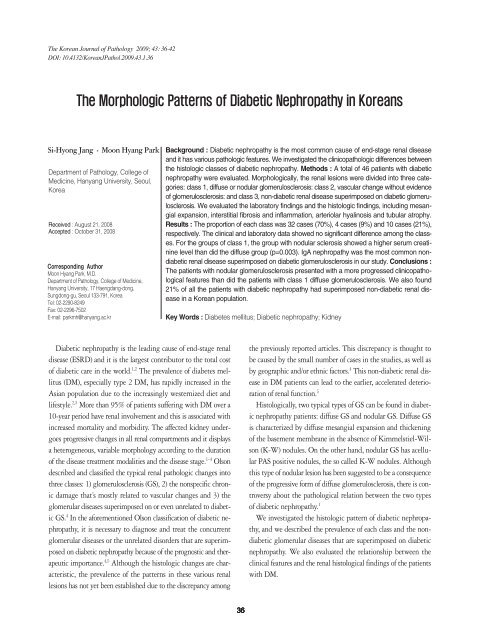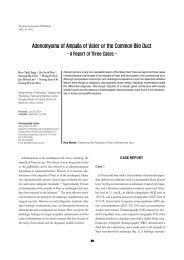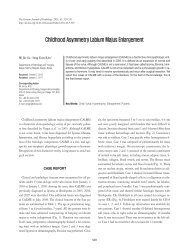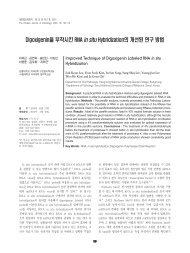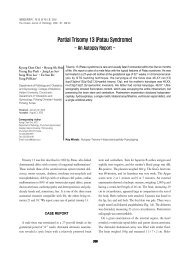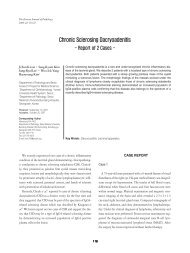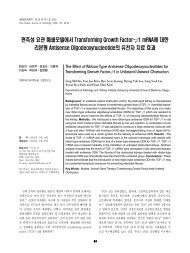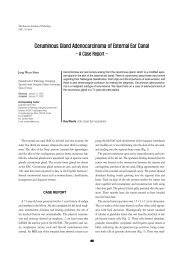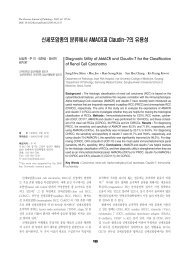Si-Hyong Jang Moon Hyang Park - KoreaMed Synapse
Si-Hyong Jang Moon Hyang Park - KoreaMed Synapse
Si-Hyong Jang Moon Hyang Park - KoreaMed Synapse
Create successful ePaper yourself
Turn your PDF publications into a flip-book with our unique Google optimized e-Paper software.
The Korean Journal of Pathology 2009; 43: 36-42<br />
DOI: 10.4132/KoreanJPathol.2009.43.1.36<br />
The Morphologic Patterns of Diabetic Nephropathy in Koreans<br />
<strong>Si</strong>-<strong>Hyong</strong> <strong>Jang</strong><br />
<strong>Moon</strong> <strong>Hyang</strong> <strong>Park</strong><br />
Department of Pathology, College of<br />
Medicine, Hanyang University, Seoul,<br />
Korea<br />
Received : August 21, 2008<br />
Accepted : October 31, 2008<br />
Corresponding Author<br />
<strong>Moon</strong> <strong>Hyang</strong> <strong>Park</strong>, M.D.<br />
Department of Pathology, College of Medicine,<br />
Hanyang University, 17 Haengdang-dong,<br />
Sungdong-gu, Seoul 133-791, Korea<br />
Tel: 02-2290-8249<br />
Fax: 02-2296-7502<br />
E-mail: parkmh@hanyang.ac.kr<br />
Background : Diabetic nephropathy is the most common cause of end-stage renal disease<br />
and it has various pathologic features. We investigated the clinicopathologic differences between<br />
the histologic classes of diabetic nephropathy. Methods : A total of 46 patients with diabetic<br />
nephropathy were evaluated. Morphologically, the renal lesions were divided into three categories:<br />
class 1, diffuse or nodular glomerulosclerosis: class 2, vascular change without evidence<br />
of glomerulosclerosis: and class 3, non-diabetic renal disease superimposed on diabetic glomerulosclerosis.<br />
We evaluated the laboratory findings and the histologic findings, including mesangial<br />
expansion, interstitial fibrosis and inflammation, arteriolar hyalinosis and tubular atrophy.<br />
Results : The proportion of each class was 32 cases (70%), 4 cases (9%) and 10 cases (21%),<br />
respectively. The clinical and laboratory data showed no significant difference among the classes.<br />
For the groups of class 1, the group with nodular sclerosis showed a higher serum creatinine<br />
level than did the diffuse group (p=0.003). IgA nephropathy was the most common nondiabetic<br />
renal disease superimposed on diabetic glomerulosclerosis in our study. Conclusions :<br />
The patients with nodular glomerulosclerosis presented with a more progressed clinicopathological<br />
features than did the patients with class 1 diffuse glomerulosclerosis. We also found<br />
21% of all the patients with diabetic nephropathy had superimposed non-diabetic renal disease<br />
in a Korean population.<br />
Key Words : Diabetes mellitus; Diabetic nephropathy; Kidney<br />
Diabetic nephropathy is the leading cause of end-stage renal<br />
disease (ESRD) and it is the largest contributor to the total cost<br />
of diabetic care in the world. 1,2 The prevalence of diabetes mellitus<br />
(DM), especially type 2 DM, has rapidly increased in the<br />
Asian population due to the increasingly westernized diet and<br />
lifestyle. 2,3 More than 95% of patients suffering with DM over a<br />
10-year period have renal involvement and this is associated with<br />
increased mortality and morbidity. The affected kidney undergoes<br />
progressive changes in all renal compartments and it displays<br />
a heterogeneous, variable morphology according to the duration<br />
of the disease treatment modalities and the disease stage. 1-4 Olson<br />
described and classified the typical renal pathologic changes into<br />
three classes: 1) glomerulosclerosis (GS), 2) the nonspecific chronic<br />
damage that’s mostly related to vascular changes and 3) the<br />
glomerular diseases superimposed on or even unrelated to diabetic<br />
GS. 4 In the aforementioned Olson classification of diabetic nephropathy,<br />
it is necessary to diagnose and treat the concurrent<br />
glomerular diseases or the unrelated disorders that are superimposed<br />
on diabetic nephropathy because of the prognostic and therapeutic<br />
importance. 4,5 Although the histologic changes are characteristic,<br />
the prevalence of the patterns in these various renal<br />
lesions has not yet been established due to the discrepancy among<br />
the previously reported articles. This discrepancy is thought to<br />
be caused by the small number of cases in the studies, as well as<br />
by geographic and/or ethnic factors. 4 This non-diabetic renal disease<br />
in DM patients can lead to the earlier, accelerated deterioration<br />
of renal function. 5<br />
Histologically, two typical types of GS can be found in diabetic<br />
nephropathy patients: diffuse GS and nodular GS. Diffuse GS<br />
is characterized by diffuse mesangial expansion and thickening<br />
of the basement membrane in the absence of Kimmelstiel-Wilson<br />
(K-W) nodules. On the other hand, nodular GS has acellular<br />
PAS positive nodules, the so called K-W nodules. Although<br />
this type of nodular lesion has been suggested to be a consequence<br />
of the progressive form of diffuse glomerulosclerosis, there is controversy<br />
about the pathological relation between the two types<br />
of diabetic nephropathy. 1<br />
We investigated the histologic pattern of diabetic nephropathy,<br />
and we described the prevalence of each class and the nondiabetic<br />
glomerular diseases that are superimposed on diabetic<br />
nephropathy. We also evaluated the relationship between the<br />
clinical features and the renal histological findings of the patients<br />
with DM.<br />
36
Renal Pathology of Diabetes Mellitus 37<br />
MATERIALS AND METHODS<br />
Patients and study design<br />
From March 1988 to May 2007, 46 patients with various renal<br />
diseases underwent renal biopsy at five general hospitals. All the<br />
histologic examination procedures, histologic diagnoses and morphologic<br />
assessments of renal damage were done in our pathology<br />
department. All the patients had been clinically diagnosed<br />
with diabetes mellitus. Two patients had undergone a simple<br />
nephrectomy due to acute emphysematous pyelonephritis and<br />
the remaining 44 patients had undergone needle biopsy. A renal<br />
biopsy was indicated when a renal disease other than diabetic<br />
nephropathy was suspected because of the presence of hematuria<br />
and/or proteinuria without diabetic retinopathy, rapidly progressive<br />
renal failure and renal insufficiency of an unexplained origin.<br />
The clinical information on the patients, including gender,<br />
age, the duration of diabetes, the total serum protein, the serum<br />
creatinine, the urinary protein excretion, and the systolic and diastolic<br />
blood pressures, were obtained by reviewing the clinical<br />
records. The male to female composition was 20 to 26 and the<br />
age distribution ranged from 23 to 70 years at the time of biopsy.<br />
The duration of diabetic illness varied from less than 1 year<br />
to 11 years. The serum creatinine levels ranged from 0.5 to 10<br />
mg/dL, and the 24-h urinary protein excretion ranged from 0.8<br />
to 12.7g.<br />
Pathologic studies<br />
The fresh renal tissue was divided into three parts and they were<br />
examined by light microscopy, immunofluorescence (IF) and electron<br />
microscopy (EM). All 46 cases were examined by light mi-<br />
A<br />
B<br />
C<br />
D<br />
Fig. 1. The histologic pattern of diabetic nephropathy is classified as diffuse glomerulosclerosis (A, methenamine silver) and nodular sclerosis<br />
(B, Masson’s trichrome). Hyaline arteriosclerosis is visible in preglomerular arterioles in all three photos (A, B, C). The histologic change<br />
in class 2 only shows vascular change without evidence of glomerulosclerosis (C, methenamine silver). Immunofluorescence staining<br />
demonstrates positive mesangial staining for IgA in the mesangium in the case of IgA nephropathy superimposed on diffuse glomerulosclerosis<br />
(D, IgA).
38 <strong>Si</strong>-<strong>Hyong</strong> <strong>Jang</strong> <strong>Moon</strong> <strong>Hyang</strong> <strong>Park</strong><br />
croscopy. Forty-four cases, all except the two nephrectomy specimens,<br />
were examined by IF. The glomerular change, as assessed<br />
by EM, was studied for the 36 cases that contained glomeruli on<br />
the EM.<br />
For light microscopy, the specimens were fixed in Dubosq-<br />
Brazil solution, embedded in paraffin, and cut into 2 μm thick<br />
sections. The serial sections were stained with hematoxylin and<br />
eosin, periodic acid-Schiff, Masson’s trichrome, and Jones’ methenamine<br />
silver.<br />
An immunofluorescence investigation was performed on the<br />
4-μm thick sections that were obtained from snap-frozen tissues,<br />
which were stained with fluoresceinated antiserum that was monospecific<br />
for IgG, IgM, IgA, C3, C1q, C4, fibrinogen, albumin<br />
and kappa and lambda light chains.<br />
For electron microscopy, the tissue was diced into 1 mm cube<br />
fragments, fixed in 2.5% buffered glutaraldehyde, processed by<br />
standard techniques and then embedded in Epon. Ultrathin sections<br />
were stained with lead citrate and these were examined on<br />
a Hitachi H-750 at 75 KV or on a Hitachi H-7600s electron<br />
microscope at 80 KV.<br />
Histologic evaluation<br />
All the cases were divided into three classes: diffuse or nodular<br />
GS (class 1), vascular change without evidence of GS (class<br />
2) and nondiabetic glomerulopathy superimposed on GS (class<br />
3) (Fig. 1). Class 1 was again subdivided into the diffuse GS and<br />
the nodular GS. The total number of glomeruli, the number of<br />
glomeruli with global or segmental sclerosis, and the presence of<br />
Kimmelstiel-Wilson nodules were evaluated in each biopsy case.<br />
The degree of mesangial expansion, the thickness of the glomerular<br />
capillary walls, the arterio- and arteriolo-sclerosis, the arteriolar<br />
hyalinosis, the tubular atrophy and interstitial inflammation<br />
and the fibrosis were graded from zero (absent) to 3+ (maximal<br />
expansion).<br />
Statistics<br />
Statistical analysis was carried out using SPSS software (SPSS,<br />
version 12.0, Chicago, IL, USA). The clinical and laboratory differences<br />
in the classes were examined for statistical significance<br />
with using one way ANOVA tests or independent T-tests. The<br />
data were expressed as means±S.E. The differences of the histologic<br />
features between the diffuse glomerulosclerosis and the<br />
nodular glomerulosclerosis were evaluated with 2<br />
tests. A p-<br />
value
Renal Pathology of Diabetes Mellitus 39<br />
Table 2. Comparison of clinical and laboratory features of diffuse glomerulosclerosis and nodular glomerulosclerosis (GS)<br />
Nodular GS<br />
Diffuse GS<br />
No. of patients 16 16<br />
Sex ratio (M/F) 1.00 0.78<br />
Age (year) 52.13±13.35 48.63±11.12<br />
Duration of diabetes (month) 173.33±123.52 116.73±110.26<br />
Serum creatinine (mg/dL)* 3.08±3.12 1.76±1.04<br />
24-h urine protein excretion (g) 7.00±4.11 4.22±2.99<br />
Systolic arterial blood pressure (mmHg)* 155.71±47.91 140.00±12.25<br />
Diastolic arterial blood pressure (mmHg) 98.33±14.72 84.00±5.48<br />
*p-value
40 <strong>Si</strong>-<strong>Hyong</strong> <strong>Jang</strong> <strong>Moon</strong> <strong>Hyang</strong> <strong>Park</strong><br />
A B C D<br />
E F G H<br />
Fig. 2. In class 3, non-diabetic renal diseases superimposed on diabetic nephrosclerosis include IgA nephropathy (A, Masson’s trichrome<br />
and B, electron micrograph, original magnification ×7,000), membranous glomerulonephropathy (C, methenamine silver ×1,000 and D,<br />
electron micrograph, original magnification ×8,000), post-infectious glomerulonephritis (E [PAS] and F [C3]) and membranoproliferative<br />
glomerulonephritis (G, methenamine silver). Large subendothelial and mesangial electron dense deposits are noted (H, original magnification<br />
×7,000).<br />
B). Two cases that underwent emergency nephrectomy for acute<br />
emphysematous pyelonephritis showed multifocal small or confluent<br />
abscesses that were associated with the underlying diffuse<br />
GS. The others were two cases of membranous glomerulonephropathy,<br />
and one case each of membranoproliferative glomerulonephritis,<br />
poststreptococcal glomerulonephritis and Batter<br />
syndrome, respectively. As we mentioned above, class 3 showed<br />
no difference in the characteristics or laboratory results from the<br />
other classes.<br />
DISCUSSION<br />
Diabetic nephropathy exhibits characteristic and unique pathologic<br />
changes in all the renal compartments, and this can be summarized<br />
as a diffuse form of mesangial sclerosis with an increase<br />
in the mesangial matrix, uniform thickening of the glomerular<br />
basement membrane, nodular lesion sometimes combined with<br />
microaneurysm, insudative or hyalinosis lesion, fibrin caps, capsular<br />
drops, and arteriolar hyalinosis. To evaluate the correlation<br />
of these histologic findings with their clinical significance, we<br />
classified the diabetic nephropathy according to renal histologic<br />
patterns, the same as was done in the previous studies 4,6 . class<br />
1 was diabetic GS (32 cases, 69.6%), class 2 showed prevailing<br />
vascular change without diffuse or nodular GS on both types of<br />
light microscopy (4 cases, 8.7%) and class 3 displayed non-diabetic<br />
glomerular disease superimposed on diabetic GS (10 cases,<br />
21.7%). Although a few previous studies have classified the morphologic<br />
pattern of diabetic nephropathy and they investigated<br />
the frequency of each class, the results were not consistent even<br />
within the same ethnic group. Mazzuco et al. 4 analyzed the renal<br />
pathologic patterns of 393 type 2 Italian DM patients and they<br />
reported that the prevalence of class 1, class 2, and class 3 was<br />
39.9%, 15.2%, and 45.03%, respectively. Another study of 52<br />
Italian DM patients demonstrated a relatively high proportion<br />
of class 2 (30.8%). 6 As compared with the previous two articles,<br />
our study showed features that were similar to the large series of<br />
Mazzuco et al. 4 The discrepancy in the prevalence rate can be explained<br />
by several causes, including the number of cases, the biopsy<br />
criteria and geographic and ethnic factors. In particular, the<br />
frequency of class 3 in DM patients has been shown to have broad<br />
variability, ranging from 12% to 45%. 6-16<br />
In view of the pathogenesis, a discrepancy exists as to whether<br />
the formation of acellular nodules is a distinct developmental pathogenic<br />
process or if it is a consequence of disease progression<br />
in patients with diffuse GS. Some investigators have reported<br />
there is little clinical difference between nodular and diffuse GS<br />
and they concluded that these two types of GS were distinctive<br />
patterns of GS. 17 On the other hand, others have suggested that<br />
nodular GS is a later stage of diabetic nephropathy and it is associated<br />
with longer durations of DM, the development of diabetic<br />
retinopathy and poor survival rates. 14,18,19 Suzuki et al. 12 demonstrated<br />
the correlation between the duration of diabetes and the<br />
increase of the mesangial matrix, glomerular sclerosis and arte-
Renal Pathology of Diabetes Mellitus 41<br />
riolar hyalinosis in patients with type 2 DM. The previous articles<br />
suggest that nodular GS may be the consequence and transformed<br />
malignant course of diffuse GS. 4,12 Our previous study 20<br />
showed that in nodular GS, the composition of the early nodules<br />
resembled that of diffuse GS. However, the late advanced<br />
nodular lesions of the nodular GS revealed decreased reactivity<br />
for type IV collagen and fibronectin at the periphery of the nodules,<br />
and type VI collagen and interstitial collagen I and III were<br />
increased in a laminated pattern in the nodules. 20 In the present<br />
study, we subdivided the class 1 into diffuse GS and nodular GS<br />
and we compared the clinical and renal pathologic features in<br />
both subclasses. The serum creatinine level, which reflects renal<br />
function, was significantly higher in the patients with nodular<br />
GS than that in the patients with diffuse GS. Although any statistical<br />
significance was not evident, the other clinical and laboratory<br />
features such as the duration of DM and increased 24-h<br />
urine protein excretion tended to be higher in the patients with<br />
nodular GS. The histologic findings showed that mesangial<br />
expansion and arteriolar hyalinosis were more prominent in the<br />
patients with nodular GS, the same as in previous studies. These<br />
clinical and pathologic findings suggested that the patients with<br />
nodular GS generally present with more progressed clinical and<br />
pathological features.<br />
Although the renal function and clinical course of patients with<br />
non-diabetic renal disease superimposed on diabetic GS are known<br />
to be dependent on the severity and extent of the diabetic GS rather<br />
than on the severity and extent of non-diabetic renal disease,<br />
recognizing this condition in DM patients is crucial to select the<br />
proper treatment modalities. 2,5,21,22 Yet diabetic GS shares similar<br />
morphologic features with a wide range of non-diabetic renal<br />
disease, including membranoproliferative glomerulonephritis,<br />
monoclonal immunoglobulin deposition disease, amyloidosis,<br />
membranous glomerulopathy and idiopathic nodular GS. When<br />
patients with a short duration of DM abruptly develop hematuria<br />
or increased proteinuria, then renal biopsy is essential to<br />
determine the possible co-existence of superimposed non-diabetic<br />
renal disease. IF, EM and their clinicopathologic correlation can<br />
be important diagnostic tools for distinguishing diabetic nephropathy<br />
from other clinical conditions. 21,22 Our study revealed that<br />
10 out of 46 patients (21.7%) belonged to class 3 and the most<br />
commonly affected renal disease was IgA nephropathy. In Korean<br />
and Chinese populations, IgA nephropathy shows a high frequency<br />
of coexistence with both diabetic nephropathy and IgA<br />
nephritis. 6 Previous studies have evaluated the clinical features<br />
and biochemical parameters of the patients with isolated diabetic<br />
GS and the patients with non-diabetic renal disease coexisting<br />
with diabetes, and they found that there was no statistical difference,<br />
except for the level of the blood pressure during follow up<br />
period. 3 The other biochemical and clinical features, including<br />
serum creatinine, 24-h urine protein excretion and the presence<br />
of microscopic hematuria, showed no significant difference. 3,5<br />
In summary, we presented the prevalence of a histologic pattern<br />
in patients with diabetic nephropathy and some evidence that<br />
several clinical factors were related to the type of diabetic GS. We<br />
found that the nodular GS has more progressed clinical features<br />
than that of the diffuse GS. We also found that 21% of all Korean<br />
patients with diabetic nephropathy have coexisting non-diabetic<br />
renal disease, which is a little lower incidence than was expected<br />
when considering that the clinicians performed renal biopsies<br />
when other superimposed lesions were clinically suspected.<br />
In conclusion, for administering the proper treatment and for<br />
exactly evaluating the prognosis of diabetic nephropathy patients,<br />
it is necessary to carefully examine the extent and the type of<br />
GS, as well as to determine if there are superimposed non-diabetic<br />
renal lesions.<br />
REFERENCES<br />
1. Hong D, Zheng T, Jia-qing S, Jian W, Zhi-hong L, Lei-shi L. Nodular<br />
glomerular lesion: a later stage of diabetic nephropathy? Diabetes Res<br />
Clin Pract 2007; 78: 189-95.<br />
2. Gross JL, de Azevedo MJ, <strong>Si</strong>lveiro SP, Canani LH, Caramori ML, Zelmanovitz<br />
T. Diabetic nephropathy: diagnosis, prevention, and treatment.<br />
Diabetes Care 2005; 28: 164-76.<br />
3. Wong TY, Choi PC, Szeto CC, et al. Renal outcome in type 2 diabetic<br />
patients with or without coexisting nondiabetic nephropathies. Diabetes<br />
Care 2002; 25: 900-5.<br />
4. Mazzucco G, Bertani T, Fortunato M, et al. Different patterns of renal<br />
damage in type 2 diabetes mellitus: a multicentric study on 393 biopsies.<br />
Am J Kidney Dis 2002; 39: 713-20.<br />
5. Lee EY, Chung CH, Choi SO. Non-diabetic renal disease in patients<br />
with non-insulin dependent diabetes mellitus. Yonsei Med J 1999;<br />
40: 321-6.<br />
6. Gambara V, Mecca G, Remuzzi G, Bertani T. Heterogeneous nature<br />
of renal lesions in type II diabetes. J Am Soc Nephrol 1993; 3: 1458-66.<br />
7. Monga G, Mazzucco G, Barbiano di Belgiojoso G, Confalonieri R,<br />
Sacchi G, Bertani T. Pattern of double glomerulopathies. A clinicopathologic<br />
study in nine nondiabetic patients. Nephron 1990; 56:<br />
73-80.<br />
8. Amoah E, Glickman JL, Malchoff CD, Sturgill BC, Kaiser DL, Bolton<br />
WK. Clinical identification of nondiabetic renal disease in diabetic
42 <strong>Si</strong>-<strong>Hyong</strong> <strong>Jang</strong> <strong>Moon</strong> <strong>Hyang</strong> <strong>Park</strong><br />
patients with type I and type II disease presenting with renal dysfunction.<br />
Am J Nephrol 1988; 8: 204-11.<br />
9. Parving HH, Gall MA, Skott P, et al. Prevalence and causes of albuminuria<br />
in non-insulin-dependent diabetic patients. Kidney Int 1992;<br />
41: 758-62.<br />
10. Kleinknecht D, Bennis D, Altman JJ. Increased prevalence of non-diabetic<br />
renal pathology in type II diabetes mellitus. Nephrol Dial Transplant<br />
1992; 7: 1258-9.<br />
11. Richards NT, Greaves I, Lee SJ, Howie AJ, Adu D, Michael J. Increased<br />
prevalence of renal biopsy findings other than diabetic glomerulopathy<br />
in type II diabetes mellitus. Nephrol Dial Transplant 1992; 7: 397-9.<br />
12. Suzuki Y, Ueno M, Hayashi H, et al. A light microscopic study of<br />
glomerulosclerosis in Japanese patients with noninsulin-dependent<br />
diabetes mellitus: the relationship between clinical and histological<br />
features. Clin Nephrol 1994; 42: 155-62.<br />
13. John GT, Date A, Korula A, Jeyaseelan L, Shastry JC, Jacob CK. Nondiabetic<br />
renal disease in noninsulin-dependent diabetics in a south<br />
Indian Hospital. Nephron 1994; 67: 441-3.<br />
14. Olsen S, Mogensen CE. How often is NIDDM complicated with nondiabetic<br />
renal disease? An analysis of renal biopsies and the literature.<br />
Diabetologia 1996; 39: 1638-45.<br />
15. Mak SK, Gwi E, Chan KW, et al. Clinical predictors of non-diabetic<br />
renal disease in patients with non-insulin dependent diabetes mellitus.<br />
Nephrol Dial Transplant 1997; 12: 2588-91.<br />
16. Wirta O, Helin H, Mustonen J, Kuittinen E, Savela T, Pasternack A.<br />
Renal findings and glomerular pathology in diabetic subjects. Nephron<br />
2000; 84: 236-42.<br />
17. Schwartz MM, Lewis EJ, Leonard-Martin T, Lewis JB, Batlle D. Renal<br />
pathology patterns in type II diabetes mellitus: relationship with retinopathy.<br />
The Collaborative Study Group. Nephrol Dial Transplant<br />
1998; 13: 2547-52.<br />
18. Murussi M, Baglio P, Gross JL, <strong>Si</strong>lveiro SP. Risk factors for microalbuminuria<br />
and macroalbuminuria in type 2 diabetic patients: a 9-year<br />
follow-up study. Diabetes Care 2002; 25: 1101-3.<br />
19. Gall MA, Hougaard P, Borch-Johnsen K, Parving HH. Risk factors<br />
for development of incipient and overt diabetic nephropathy in patients<br />
with non-insulin dependent diabetes mellitus: prospective, observational<br />
study. BMJ 1997; 314: 783-8.<br />
20. Paik SS, <strong>Park</strong> MH. Immunohistochemical localization of extracellular<br />
matrix components in diabetic nephropathy. Korean J Pathol 1997;<br />
31: 427-35.<br />
21. Alsaad KO, Herzenberg AM. Distinguishing diabetic nephropathy<br />
from other causes of glomerulosclerosis: an update. J Clin Pathol 2007;<br />
60: 18-26.<br />
22. Lai FM, Li PK, Pang SW, et al. Diabetic patients with IgA nephropathy<br />
and diabetic glomerulosclerosis. Mod Pathol 1993; 6: 684-90.


